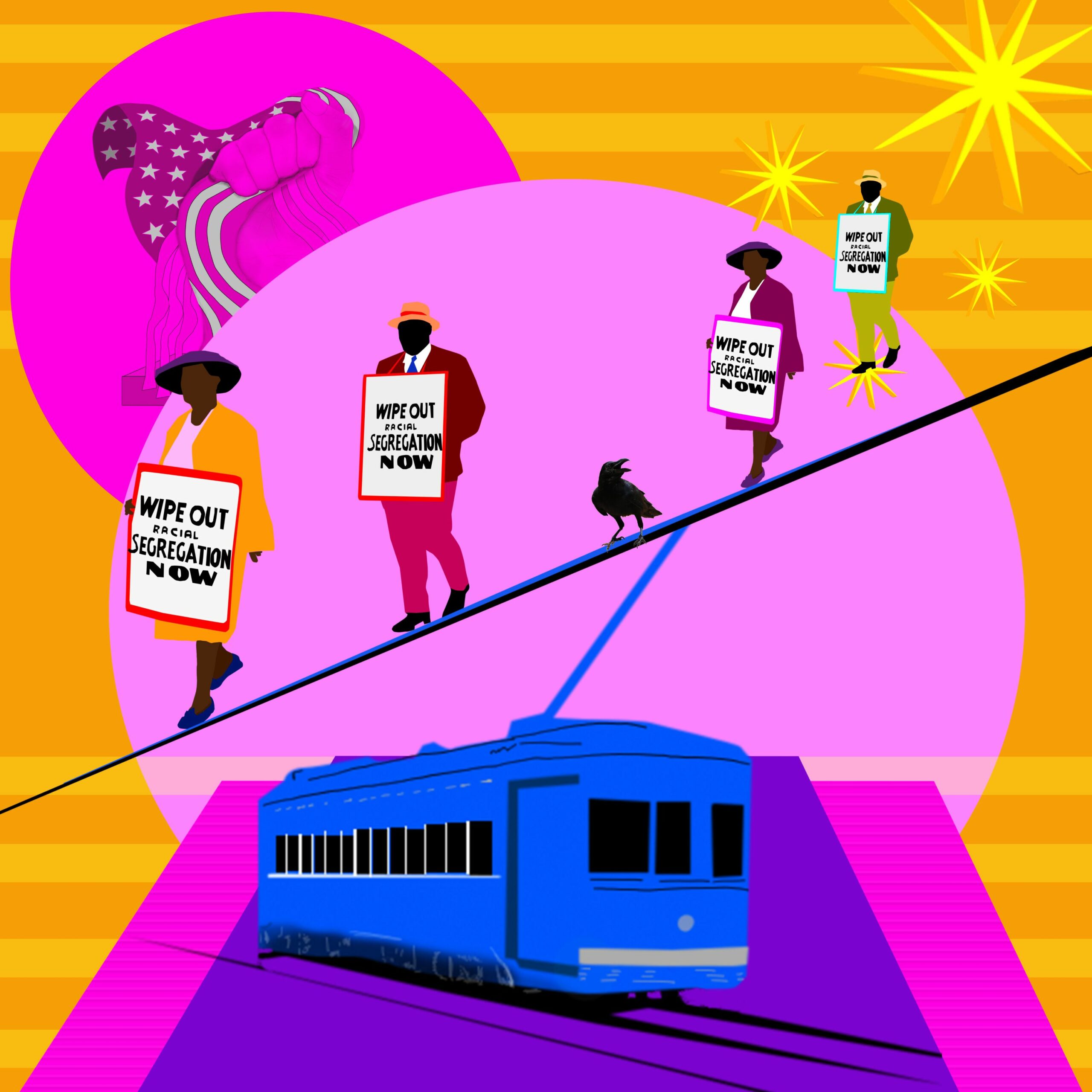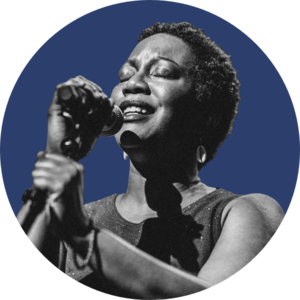
With white supremacist strategies for segregated societies solidifying in towns across America’s South, Black people needed to respond in ways that would ensure the freedoms their predecessors had fought to codify into law remained available to them.
Between 1900 and 1910, in more than two dozen cities, African Americans tried to stem the tide of their exclusion from public life by taking the fight to the streets, boycotting streetcars that divided Black and white passengers.
The pressure applied by these protests wasn’t successful in every instance, but the victories that were won inspired continued activism and pushback against the expansion of Jim Crow laws across the nation.
View Transcript
Unidentified White Man: I live away in the South End and having neither a horse nor carriage was forced to foot it to town.
KEW: As the man made his way to the business district, the streets and sidewalks became increasingly choked with commuters on foot. The man likely added to the chorus of bothered grumbles getting louder as the sun rose and the heat intensified. Unaccustomed to that kind of hike, and with a long way to go, he looked for relief.
UWM: A conveyance came along driven by a Negro and I asked him for a lift. Looking at me and grinning, he said: “Boss, I’m obliged to refuse you the favor. The City Council won’t let the white folks and the black folks ride together.” And with that, he drove on.
KEW: The driver’s wry “nope” spoke volumes. A new law in Houston had segregated public transportation for almost a year. City Council wanted to draw and uphold the color line to keep white people from the social “inconvenience” of riding side by side with Black Houstonians on their commutes. But now this white businessman was inconvenienced by a worker’s strike and was asking a Black driver for a lift.
In response to the unjust law, most Black Houstonians avoided streetcars altogether. The boycott lasted so long and had such an impact that it was reported as far away as Maryland, in the Baltimore Sun:
Baltimore Sun: The Negroes of Houston have boycotted the streetcars here since the Jim Crow cars, separating the races, began to run. They have organized and are fighting the innovation with all their might.
KEW: Black hack drivers used wagons and carriages to ferry the city’s Black business and working people to and from work and about their daily affairs, even lowering their fares to support the cause of boycotting public transportation.
BS: One Negro church is reported by one of its members to have contributed nearly $300 to the movement, which is to be spent in maintaining a hack transportation system for the accommodation of Negroes.
KEW: And the community was adamant that people fall in line with the boycott:
BS: It is reported that the Negro churches have threatened their members with expulsion if they ventured to ride upon the cars of the Houston Electric Company, and that many secret societies threatened their members with expulsion also if they patronize the street cars. In some cases Negro washer women have gone on strike in order to induce their white patrons to advocate a change in the car system.
KEW: Black people in Houston’s Fourth Ward, who usually rode the San Felipe streetcar line, took the boycott to the next level. During the day, they jeered at the few Black passengers who still used the service, mocking them for riding in the “bobtail” of the car. A Black woman was arrested and fined early on for throwing stones at the passing San Felipe line.
Houston Post: The conductors reported that the cars were stoned on every trip. The car was always stopped and every effort made to ascertain who the guilty parties were but without avail. While the Negroes stood around and jeered, all denied any knowledge of who had thrown the stones, stating that they had not seen anyone do it.
KEW: When white Houstonians realized that their own business interests were being interrupted, they questioned why Black Houstonians would give one another rides, but exclude white patrons. Black Houstonians answered with actions, not words.
BS: The Negroes are silent when questioned, saying that they are attending strictly to their own business and the white people can attend to theirs.
HP: The Negroes seemed to enjoy the predicament of the whites hugely, and many of their conveyances could be seen driving about the streets with the space in the rear some 2 feet in length blocked off by a piece of cardboard bearing the legend, “For Whites only.”
KEW: Southern streetcar companies, like Houston Electric, initially opposed the segregation ordinance. But their bottom lines were no match for the color line’s popularity with the white majority, who rolled their eyes at the protests in the local press.
HP: There was much comment among the white people as to how long the Negroes would keep up the boycott, it being the consensus of opinion that within the next few days they will realize that a separation of the races on the streetcars is a fact, and that then they will gradually patronize the service.
KEW: That prediction was wrong.
This is Seizing Freedom. Jim Crow in the South as we know it didn’t emerge overnight. White people had to figure out an architectural design to legally force Black people (who had had their time in freedom’s sun) back to their “rightful place” at the “bottom of [American] life”. A key part of that plan was to physically separate races—to design a world bound by walls and screens or arbitrary invisible lines on sidewalks and streetcars—forcing white and Black people to move through space differently so that they wouldn’t have to interact with one another on equal terms.
In this episode: how a segregated society was built brick by brick, streetcar by streetcar, town by town, and state by state after a Supreme Court decision. And how race men and women—those black people combating white supremacy at every turn—tried to fight back.
Protests of segregated public transportation didn’t start or end in the mid-1950s in Montgomery, Alabama. African Americans fought for their dignity and the right to equal public spaces across the South from the very beginning of the 20th century.
By the winter of 1903, Black Houstonians had been resisting the spirit and violence of segregation for 8 months. There was no sign of letting up. And they were not alone. They were part of a huge movement of Black southerners protesting streetcar segregation. Between 1900 and 1910, in more than two dozen cities—from Mobile to Savannah, from Jacksonville to Richmond—African Americans tried to stem the tide of their exclusion from public life by taking the fight to the streets and streetcars.
Crowley Post Signal: The Negroes of Jacksonville, FL, are said to be indignant over the passing of an ordinance in the city council requiring the separation of white and Colored people on the street cars. They threatened to boycott the cars and use hacks and herdics.
John Mitchell, Jr.: For a week, the Colored people have studiously applied themselves to walking [in Richmond, Virginia]. The Clay St. line, which usually carries a packed crowd of Colored people both morning and evening, has been avoided.
Mobile Daily Register: In every city where it has been found advisable to separate the races in the streetcar the experience has been the same. The Negroes have invariably decided a boycott.
KEW: One thing was clear, the Houston Post reported: during the streetcar boycott of 1903 and 1904, “the Negroes were prepared and the whites were not.”
Before streetcars, there was segregation and protests on railroads. During Reconstruction, Black professionals and business people traveling by train were routinely subjected to assaults on their dignity of paying for first-class tickets only to be forced to ride in worse than coach conditions—what white supremacists called “the Negro car”—which could be dirty luggage compartments.
If they objected to dismissals of their personhood, or their exclusion from first-class car seats they purchased, white conductors and passengers retaliated with brutal force. That’s what happened to a twenty-year-old Ida B. Wells in 1883. Although not yet the formidable activist who took the world by storm protesting lynching, Wells was already a crusader for justice. At the time, she was a teacher living in Memphis and earning $30 a month. That kind of income meant she could afford first-class accommodations. And her steady job gave her the leisure time to visit parks, libraries, the opera, and coffee houses—all the new places where the “color line” was being drawn. When Wells boarded a train in Memphis:
Ida B. Wells: There was no person on the seat with me and I was the only colored person in that car. A mile or so from Memphis, the conductor came collecting tickets. He took mine, looked at me, and returned it to me, saying he could not accept it in that car. [He] said that I would have to go to the coach in front, that I was in the wrong car. To this I replied, that I would not ride in the forward car, that I had a [ticket for my] seat and intended to keep it. He said to me that he would treat me like a lady, but that I must go into the other car, and I replied that if he wished to treat me like a lady, he would leave me alone.
He then took hold of me to carry me to the other car. I resisted him—holding on to my seat—when he called for help, and two white passengers helped him to carry me out. I resisted all the time, and never consented to go. My dress was torn in the struggle. One sleeve [of my dress] was almost torn off. Everybody in the car seemed to sympathize with the conductor, and were against me. I got off the train refusing to go into the forward coach. I paid 30¢ for my ticket and still hold it.
KEW: After the incident, Wells won a lawsuit against the railroad company, but then lost on appeal. In rural communities, with most Black people sinking under tenancy, living and working in the same intimate proximity to whites and with the same racial power dynamics they had during slavery, white people were not interested in or calling for segregation.
But towns and cities large enough to provide first-class accommodations and entertainment, were another story. There, whites of all classes were confronted by Black people’s success, and the majority wanted to crush it. In 1901, North Carolina Congressman George Henry White assessed Black economic progress made in the last few decades, during Reconstruction.
Rep. George White: We are successfully operating several banks [and] commercial enterprises among our people in the Southland, including one silk mill and one cotton factory. We have built about 20,000 churches, and support seven colleges, 17 academies, 50 high schools, five law schools, five medical schools, and 25 theological seminaries. All this we have done under the most adverse circumstances.
KEW: White supremacists across class and geographic lines hated the strides African Americans were making. White grievance brought forth a shadow army that targeted hard-working men and women, clawing to get ahead. It especially attacked those who defied white supremacy. Its goal was to hoard privilege and power by rolling back Black progress.
Black people in Southern cities had come up from recent or distant slavery, but had been able to make the most of Reconstruction. While many Black Southerners claimed their dignity by migrating elsewhere, most remained. They found honor in staying to fight right where they were. Tough, resourceful, and independent, by 1900 Black Southerners had served in all elected offices. They had gone to school and even college, which powered their ascendancy in education, medicine, the law, science, technology and the arts. They built and sustained institutions and businesses from scratch, where they partied, worshiped, danced and manifested black beauty in all its forms.
This rising Black middle and elite class became power brokers for urban communities, with the financial means to pursue first-class accommodations and amusements, and the unapologetic and legal entitlement to enjoy them.
RGW: We have nearly 300 newspapers, three of which are dailies. We have now in practice over two thousand lawyers and a corresponding number of doctors. We have about 140,000 farms and homes, valued at in the neighborhood of $750 million and personal property valued at about $170 million.
KEW: But just as Black southerners were staking a claim to public citizenship in numbers previously unheard of, the Supreme Court put its foot in it. Throughout the 1890s, southern cities and states had been enacting laws excluding African Americans from the public places that their tax dollars helped pay for: parks, colleges and universities, and streetcars.
In 1896, Homer Plessy, the public face of a large contingent of Black New Orleanians, tried to fight the indignities of a new streetcar ordinance. These activists argued that segregation carried a “badge” or “incident of inferiority” linked to slavery, and that it violated the Thirteenth Amendment. The Court disagreed.
SCOTUS Majority: If this be so, it is not by reason of anything found in the act, but solely because the Colored race chooses to put that construction upon it.
KEW: The Supreme Court majority argued that even if social prejudice was at play in Plessy’s case, it was beyond the scope of the Court to force integration. The Court only dealt in civil and legal matters; not social ones.
SCOTUS Majority: If the civil and political rights of both races be equal, one cannot be inferior to the other civilly or politically. If one race be inferior to the other socially, the Constitution of the United States cannot put them upon the same plane.
KEW: The Supreme Court’s ruling against Plessy solidified the mortar between the bricks of Jim Crow that separated Black Americans from their constitutionally guaranteed citizenship and rights to equality. Mandated segregation in cities like Houston, and in states like Louisiana, blossomed after the Plessy ruling.
Perhaps the most visible statutes segregating public life happened in the streets—literally. One municipality would pass a transportation ordinance and another would follow. Then whole states would be inspired—and inspire one another—to pass similar laws that targeted Black urban professionals, the hub of the wheel of racial progress in the South. Southern segregationists started with streetcars for a reason. The white journalist Ray Stannard Baker wrote:
Ray Stannard Baker: The streetcar is an excellent place for observing the points of human contact between the races…in almost no other relationship do the races come together, physically, on anything like a common footing. In their homes and in ordinary employment, they meet as master and servant; but in the street cars they touch as free citizens, each paying for the right to ride, the white not in a place of command, the Negro without an obligation of servitude. Street-car relationships are, therefore, symbolic of the new conditions.
KEW: And segregationists would not stand for it. Social rules for transportation on southern streetcars were printed in newspapers for everyone to see. In Arkansas, particularly, things got very specific.
Arkansas Gazette 1: Negroes will be seated in the rear seats…The whites will occupy the front seat first, then the second, third, fourth and fifth seat, and so on. On cars in which the seats are sideways, the two rear corners are to be occupied by Negroes if there are more than one on board. Negroes cannot ride on special cars, such as Glenwood Park and cars to the baseball games. Only the regular cars are to be divided. Special cars may be run for Negroes, however.
KEW: Advocates of segregation hid behind the cloak of civility and expressed a simple interest in limiting interracial “friction.” But white newspapers and lawmakers didn’t acknowledge the reality: that white people—who demanded that Black people cave to the law and give up their rights—were usually the antagonists.
“Friction” emerged when seats filled and white riders found themselves sitting next to their social equals (and sometimes their betters): Black business and working people. Or when whites were forced to stand in cars filled with black riders who boarded before them, and who continued to remain seated, minding their business.
One newspaper reported that, before Jacksonville’s 1905 segregation ordinance went into effect, a conductor physically threw a young Black woman off a street car after she refused to give up her seat to a white woman who boarded after she did.
New York Age: Being in a delicate condition, [the young Colored lady] died about two weeks afterward. No action has been taken in the case.
KEW: The white passenger sat in the comfort white supremacy afforded her while the black woman died from her injuries. For supporters and enforcers of segregation, the balance of white power was restored.
NYA: Since the boycott, the daily papers here are trying to coax Afro-Americans back on the cars by showing that the separation of the races on streetcars is as troublesome to the whites as to the Blacks; but no such shuffling imposes upon the Afro-Americans here.
KEW: Black southerners saw beneath the veneer. They knew that segregated cars were supposed to eliminate white “anxiety” and “discomfort” and give white people exclusive rights to public space. But between lynching and a rash of disfranchisement laws, aspiring Black men were being removed from political office, clearing the way for white legislative dominance.
In 1901, at the beginning of the streetcar movement, George Henry White was the last remaining African American member of Congress until 1929. In his last speech before the House he said:
RGW: This is perhaps the Negro’s temporary farewell to the American Congress; But let me say, phoenix-like he will rise up someday and come again. These parting words are on behalf of an outraged, heartbroken, bruised, and bleeding but God-fearing people—faithful, industrious, loyal people—rising people, full of potential force.
KEW: To rise, African Americans would have to resort to other means of protest, outside the courts and Congress.
As the latticework of Jim Crow was erected in the early 1900s, more than 25 cities across the South saw boycotts against public accommodations governed by racist, restrictive laws. Race men and women bristled at the idea that all whites deserved to be elevated to first-class spaces, irrespective of their economic social class and behavior.
New Orleans Louisianan: The most respected Colored citizens of our community are deprived of the pleasures and benefits of these resorts by the glaring insults offered them, by bluntly refusing to accommodate them to refreshment in common with others…While the most despicable, or depraved white man or woman, can enjoy the hospitality as bountifully as our most respected white citizens.
KEW: Early segregation was about making sure Black professionals and business people had no choice but to accept a place at the bottom of the social hierarchy, especially in public spaces. And Black southern activists, from New Orleans to Little Rock, said “Nah.”
When the Arkansas legislature was debating a streetcar segregation bill in 1903, Little Rockians voiced their protest at a mass meeting at First Baptist Church. Members of the Black professional and business classes told themselves that their communities, which they had enriched, wouldn’t dare segregate them. But the meeting wasn’t enough to block the bill.
Arkansas Gazette 2: An old woman of the gradually-growing extinct before-the-war Mammy-class, boarded the car. She went near the front and took a seat. The conductor told her she would have to move to the rear seat and explained the new law. She opened her eyes wide and refused to move, saying: “Go along, Mr. Conductor. I was born among white folks, raised with them and still live with them, and I’m going to ride in the car with them. I’m going to sit just where I please, in this here car.” She could not be induced to move until a threat of police was made.
KEW: Indignant Black southerners might have felt a moral responsibility to disobey unjust laws. Disfranchisement stripped them of the political power they needed to reverse injustice. And they knew lynching and massacres were the real power behind the niceties of the law. Voice of the Twentieth Century, a Black university newspaper on the North End of town, advised:
Voice of the Twentieth Century: Never mind about framing resolutions or arguing the merits or demerits of this affair with anyone. Let no one get on the cars and attempt to undo what the legislature of the great state of Arkansas has done.
KEW: Individual Black protests on streetcars, editors knew, were more likely to end in expensive and violent arrests, and killings for those who exercised self-defense—which might set off white rampages and massacres.
VOTC: This law was intended to humiliate Negroes, and every time a Negro man, woman or child goes to the back or right on the cars while this iniquitous law is enforced, the Negro is humiliated. Simply stay off the cars. Stay off the cars.
KEW: Boycotts were a conservative but tactical form of protest. Their hope was that boycotts would lead to financial burdens for streetcar company owners, who would then use their influence to pressure legislators to change the law.
Most Black men in the South were being rapidly disfranchised: poll taxes, property requirements, literacy tests, and threats of violence kept them away from the ballot and political office. So Black people’s protests carried social weight, but little political weight. But that didn’t stop activists from trying.
Arkansas Gazette 1: [Black Little Rock residents] have organized a “We Walk” league, of which the porter at a 5th Street saloon is president. At a recent meeting there is said to have been a resolution adopted, providing that any member found riding on the streetcar should be fined a stated sum, [and] each ride to constitute a separate offense.
KEW: That a porter, who worked at a saloon, was the president of the “We Walk League”, reveals the particularly urban nature of streetcar protests. Working people who often had jobs on the other side of town from their homes—mail carriers, domestic workers, porters—used streetcars to travel and represented a good portion of those walking during boycotts.
On the one hand, the boycotts in Arkansas worked. The efforts of the We Walk League in Little Rock had a domino effect. Black people in Pine Bluff and Hot Springs boycotted, too. Streetcar operators observed a 90% drop in Black ridership across the three cities. Car companies soon groaned under the financial losses from boycotts, which saw reductions of Black riders on just one line from 60% to 5%.
But refusing to bow to Jim Crow legislation was a choice only the privileged few could make for long. When forced to choose between gainful employment and giving white supremacist policies the good fight, most Black people erred on the side of making ends meet. While the Black populations in southern cities were large and growing, the professional and business class only represented a small percentage of streetcar ridership in Arkansas. Streetcar companies—under the management of white men like Trawick—decided to ride the boycotts out.
J.A. Trawick: We expected that the Negroes would boycott us at first, but in a week they will be riding again…
KEW: Streetcar companies were feeling protests in their pockets. But segregationists in southern legislatures were unmoved. They stood fast, and the law stuck. Black Little Rockians kept up their protests for several weeks, from May 27th to sometime in late July of 1903. While the We Walk! League never publicly announced its defeat, Black Arkansans gradually started riding streetcars again.
The protests in Arkansas weren’t failures, even if they didn’t change the law immediately. Across the nation, the Black press reported boycotts and inspired similar efforts far and wide. Under the right conditions—in cities with larger Black professional and business classes—boycotts could make an impact.
In the spring of 1904, when the Virginia Passenger and Power Company announced that it was enacting segregation on its streetcars in Richmond, Manchester, and Petersburg, Black elites were ready and resolute. At a mass meeting that included John Mitchell, Jr., editor of The Richmond Planet, “bankers, lawyers, businessmen, and college professors,” voted to:
John Mitchell Jr: …do all in their power to promote peace and avoid any clash or disorder on the streetcars. It was decided that the best way to do this would be to walk and stay off the Virginia Passenger and Power Company’s cars.
KEW: Other local elites took the stage and added their voices. A Mr. W. W. Fields recommended salt water baths for feet to re-adapt them to the habit of walking so much. A Mrs. Patsy K. Anderson advised the audience “in terse and explicit language” to do no loud-talking, no arguing, no fighting.” Do “nothing but walk, walk, walk,” she said, receiving thunderous applause.
JMJ: The good Lord has blessed most of us with big feet and we see no reason why we should not start early to work and proceed to use them. If the entire population or at least 90% of it would agree to make the sacrifice and walk for a year, the agony produced on the White man’s nerve center, which is his pocket, would tend to cause an amelioration of our condition.
KEW: Like protesters they had observed in other cities, Richmonders wanted to make what Mitchell called a “dignified and conservative” protest, meaning Black professionals and businesspeople wouldn’t put themselves at risk for throwing or catching hands. Instead, they would decline second-class service by refusing to ride.
But Black Richmond elites wanted more than to avoid trouble or hurt white power brokers’ bottom lines. They also wanted to make plain a point that has been lost in much of the mainstream, white memory of Jim Crow: Black people never wanted physical proximity to white people, as white people so often assumed.
Banker Maggie L. Walker wrote in her paper, the St. Luke Herald, that the streetcar ordinance should technically go even further:
Maggie L. Walker: We understand that in a few days we are to have “Jim Crow” streetcars running on our streets. While this is done to degrade and humiliate us, we are not at heart sorry that it has been done. We want our white friends who are so anxious to erect every possible barrier they can to keep Negroes from touching or rubbing against white people to make full and complete success of the job. We would like to see the streets and stores Jim Crowed. We want a real, sure-enough separation.
KEW: Black elites like Walker believed that having their designated spaces shrunk to accommodate whites, violated their rights to equality. Many called for completely separate, equally maintained spaces as a solution. That started with abandoning the unequally segregated streetcars.
Like Maggie Walker, John Mitchell also owned and operated a bank. He had a reasonable amount of financial stability and political pull, and he put both to use. Mitchell and three other bank presidents pledged their financial support for individuals and organizations willing to provide alternative transportation to Black protestors across town. Individual action backed by a collective of elite Black businessmen and women, made Richmond’s efforts more successful than places like Arkansas.
JMJ: Between 80 to 90% of the Colored people who have used the streetcars are now walking. It is a common thing to see streetcars with the front part filled and the rear part empty. Some Colored people who popped their pride out of respect for their feelings insist upon standing up on the platforms as there is no discrimination there, and they only move inside when they receive positive orders from the conductors.
KEW: On April 30th, 1904, The Richmond Planet claimed a victory: with its larger Black middle and professional classes, along with sister boycotts and competing transit services in Norfolk and Portsmouth, the state’s Black elite delivered a strong enough blow to drive Virginia Passenger and Power out of business.
Protests against segregation registered indignation, but they weren’t as effective as corrective public policy. To break the color line, African Americans needed political power. But in the first decade of the 20th century, with many of them disfranchised in the South or voting, but in not enough numbers to flex political capital or accountability in the North and West, they wouldn’t move the needle for another two decades.
So most early streetcar boycotts failed to reverse the tide, ending within weeks or months of starting. Working and middle-class African Americans returned to the streetcars, and lived to fight another day. Unfortunately, it was going to take another 60 years for the nation’s courts to change segregation laws; to agree with Justice John Marshall Harlan, who wrote the Plessy ruling dissent:
Justice John Marshall Harlan: Our Constitution is color-blind and neither knows nor tolerates classes among citizens. In respect of civil rights, all citizens are equal before the law. The humblest is the peer of the most powerful. The law regards man as man and takes no account of his surroundings or of his color when his civil rights are involved.
The arbitrary separation of citizens, on the basis of race, while they are on a public highway, is a badge of servitude wholly inconsistent with the civil freedom and the equality before the law established by the Constitution. It cannot be justified upon any legal grounds.
KEW: Until then, boycotts seemed the best alternative. What early activists didn’t know is that they were only at the beginning of the fight ahead of them: Segregation would sweep over entire categories of employment, schools, neighborhoods, leisure spaces, hospitals, and workplaces. But their sustained protest would keep Black people’s freedom-taking spirits alive in the decades to come.
Voice Actors

Voice of John Mitchell, Jr.

Voice of Maggie L. Walker

Voice of Arkansas Gazette 1, Mobile Daily Register, SCOTUS Majority, Justice John Marshall Harlan

Voice of Baltimore Sun, Unidentified White Man

Voice of Voice of the Twentieth Century

Voice of Crowley Post Signal

Voice of Ida B. Wells

Voice of George Henry White, Ray Stannard Baker

Voice of Arkansas Gazette 2

Voice of J.A. Trawick

Voice of Houston Post, New York Age, New Orleans Louisianan
Episode Resources
The following resources were utilized in the research and creation of this episode:
- Cherisse Branch-Jones – Better Living By Their Own Bootstraps: Black Women’s Activism in Rural Arkansas, 1914-1965
- Stephanie Fuglaar – “The Streetcar in Houston” in Houston History Magazine
- Shennette Garrett-Scott – Baking on Freedom: Black Women in US Finance Before the New Deal
- Tiffany Gill – Beauty Shop Politics: African American Women’s Activism in the Beauty Industry
- Thavolia Glymph – “I Could Not Come In Unless Over Their Dead Bodies”
- John Graves – “Jim Crow in Arkansas: A Reconsideration of Urban Race Relations in the Post-Reconstruction South”
- Robin D.G. Kelley – “We Are Not What We Seem: Rethinking Black Working Class Opposition in the Jim Crow South”
- Blair L.M. Kelley – Right to Ride
- Neil R. McMillen – Dark Journey: Black Mississippians in the Age of Jim Crow
- August Meier and Elliott Rudwick – “The Boycott Movement Against Jim Crow Streetcars in the South”
- Koritha Mitchell – From Slave Cabins to the White House: Homemade Citizenship in African American Culture
- Rebecca J. Scott – “Discerning a Dignitary Offense”
